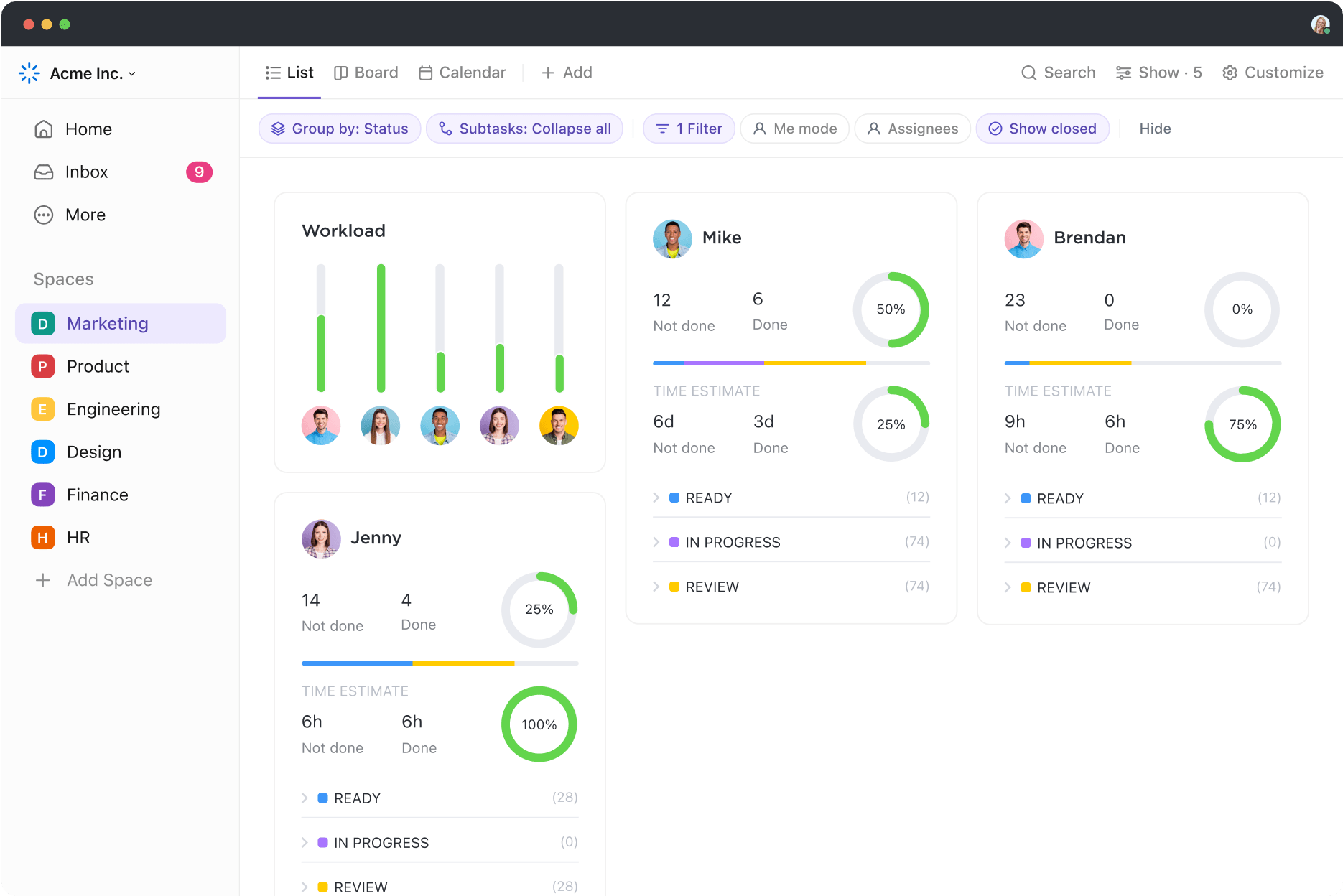دعنا نواجه الأمر: لن تتقن إدارة الفريق بين عشية وضحاها. عليك أن تكتسب الخبرة وتتعلم من المعاناة في الملعب.
ولكن هناك ما يمكننا فعله لمساعدتك على تحقيق ذلك بشكل أسرع، بدءاً من هذا المقال تحديداً. اقرأه لتتعلم ما هي مهارات إدارة الفريق وكيفية تطبيقها على فريقك كالسحر.
ما هي إدارة الفريق؟
إدارة الفريق هي الكفاءة الشاملة لمديري الفرق. وهي تضم القدرات والمعرفة والمهارات الفنية والسلوكيات المطلوبة لإدارة الفريق. ولكن ما هو مدير الفريق بالضبط؟
مدير الفريق هو المسؤول عن تنسيق عمل الفريق، بحيث يحققون ما يلي أهداف الفريق . ويتكون ذلك من تنظيم تنفيذ المهام من قبل المساهمين.
ومع ذلك، فإن مهمة مدير الفريق لا تتوقف عند مستوى التنفيذ. فهم يتحكمون في عمل الفرق لضمان تحقيق الأعمال لأهدافها على مستوى التنفيذ.
ففي نهاية المطاف، غالبًا ما تكون العمليات التنظيمية معقدة ولا يمكن أن تسير بسلاسة بدون فرق العمل. ولكن باستخدام الاستراتيجيات والأساليب الصحيحة، يمكن لقادة الفرق الحفاظ على إنتاجية وفعالية الجميع. فهم ينظمون تلك الفرق، ويبدأون العمل الجماعي، ثم يحافظون على سير العمل بمهاراتهم الإدارية الأساسية.
 إدارة الفريق هي القوة التي تدفع التقدم في جميع مهام أعضاء الفريق. على سبيل المثال، من خلال عقد اجتماعات منتظمة للفريق كمجموعة ولأعضائه بشكل فردي، يزيل مديرو الفرق العوائق التي تحول دون تقدم المشاريع ويفتحون إمكانية الوصول إلى الموارد اللازمة.
إدارة الفريق هي القوة التي تدفع التقدم في جميع مهام أعضاء الفريق. على سبيل المثال، من خلال عقد اجتماعات منتظمة للفريق كمجموعة ولأعضائه بشكل فردي، يزيل مديرو الفرق العوائق التي تحول دون تقدم المشاريع ويفتحون إمكانية الوصول إلى الموارد اللازمة.
ولكن على المستوى الشخصي، تحافظ إدارة الفريق على العلاقات السليمة بين أعضاء الفريق. بعبارة أخرى، هناك ما هو أكثر بكثير من إدارة الفريق من تنسيق العمل والتحكم فيه. دعونا نقسم المفهوم إلى أجزاء أو مهارات أصغر!
مدير الفريق مقابل قائد الفريق
يتمثل الفرق الرئيسي بين مدير الفريق وقائد الفريق في أن مدير الفريق يركز على إدارة المهام وسير العمل، بينما يركز قائد الفريق على إلهام الفريق وتوجيهه.
وعلى الرغم من أن كلا الدورين ضروريان لإدارة الفريق بفعالية، إلا أنه من الضروري فهم المسؤوليات المميزة لكل منهما. يجب أن يتمتع مديرو الفرق بمهارات تنظيمية قوية، وأن يكونوا قادرين على تفويض المهام بكفاءة، وأن يكون لديهم فهم شامل لمبادئ إدارة المشاريع.
لماذا تعتبر الإدارة الفعالة للفريق مهمة؟
الإدارة الفعالة للفريق أمر بالغ الأهمية لنجاح وإنتاجية أي منظمة. فهي تضمن إكمال المهام بكفاءة، والوفاء بالمواعيد النهائية، وتحفيز أعضاء الفريق على العمل معًا لتحقيق هدف مشترك.
فيما يلي بعض الفوائد الرئيسية لإدارة الفريق:
- الإدارة الفعالةإدارة المهام: تتضمن إدارة الفريق تفويض المهام وتحديد الأولويات والتأكد من أن كل عضو يعرف دوره في تحقيق أهداف الفريق. وهذا يساعد على تجنب الارتباك والتأخير والأخطاء في العمل.
- تواصل أفضل: يعرف مدير الفريق الجيد كيفية التواصل بفعالية مع أعضاء الفريق. وهذا يخلق شعوراً بالوضوح والشفافية، مما يؤدي إلى تفاهم وتعاون أفضل داخل الفريق.
- زيادة الإنتاجية: مع الإدارة السليمة، يمكن للفرق العمل بكفاءة أكبر نحو تحقيق أهدافها. يمكن للمدراء تحديد أي عقبات أو مشاكل قد تعيق التقدم وإيجاد حلول لإبقاء الفريق على المسار الصحيح.
- الاستخدام الأفضل للموارد: تضمن إدارة الفريق أنتخصيص الموارد بفعاليةوتقليل الهدر وتعظيم الإنتاج. وهذا يوفر الوقت والمال والجهد على المنظمة.
- تحسين العمل الجماعي والروح المعنوية: تتضمن الإدارة الفعالة للفريقخلق ثقافة عمل إيجابية حيث يشعر الجميع بالتقدير والتحفيز والدعم.
أنواع إدارة الفريق
إدارة الفريق الأوتوقراطية
تتميز الإدارة الأوتوقراطية بالسيطرة الفردية على جميع القرارات مع القليل من المدخلات من أعضاء الفريق. وعادةً ما يكون القادة الذين يتبنون هذا النمط حاسمين ويقودون بالتوجيهات.
الإدارة الديمقراطية للفريق
على النقيض من الأساليب الأوتوقراطية، تشجع الإدارة الديمقراطية على اتخاذ القرارات من خلال الاتفاق الجماعي للأعضاء، مما يعزز الشعور بالمساواة والمسؤولية المشتركة.
إدارة فريق العمل القائمة على حرية التصرف
يمثل نهج عدم التدخل، حيث يقدم مدراء عدم التدخل الحد الأدنى من التوجيه و تفويض سلطة اتخاذ القرار لأعضاء الفريق، وتعزيز بيئة من الاستقلالية والتوجيه الذاتي.
إدارة الفريق التحويلية
يهدف المدراء التحويلي إلى إلهام وتحفيز أعضاء الفريق، مع التركيز على مستويات عالية من التواصل لزيادة المشاركة ودفع التغيير الإيجابي داخل هيكل الفريق.
إدارة فريق المعاملات
يعتمد هذا النوع من الإدارة على نظام المكافآت والجزاءات لإدارة الفرق. يركز قادة المعاملات على الأداء، والكفاءة، والإنجاز الروتيني للأهداف، باستخدام سلطة وهيكلية رسمية.
إدارة الفريق الخادم
القيادة الخادمة هي نهج يركز على نمو ورفاهية أعضاء الفريق. ويعطي هؤلاء القادة الأولوية لاحتياجات الفريق ويساعدون الأفراد على تحقيق أعلى مستوى ممكن من الأداء.
إدارة الفريق متعددة الوظائف
A نهج متعدد الوظائف ينطوي على تجميع فريق يضم مجالات متنوعة من الخبرات لتحقيق هدف مشترك، وتعزيز الابتكار وحل المشاكل بشكل شامل.
إدارة الفريق الافتراضي
مع تقدم التكنولوجيا، أصبحت الإدارة الافتراضية أكثر انتشاراً. يقوم مدراء الفرق الافتراضية بتنسيق الأعضاء المتباعدين جغرافيًا، ويعتمدون بشكل كبير على أدوات التواصل الرقمي .
إدارة فريق العمل الظرفية
تشير الإدارة الظرفية إلى أنه لا يوجد أسلوب إدارة واحد يناسب جميع السيناريوهات؛ وبدلاً من ذلك، يقوم القادة بتكييف نهجهم بناءً على المهمة والظروف واحتياجات أعضاء الفريق الفردية. ويتطلب هذا الأسلوب القيادي الديناميكي مديرًا متعدد الاستخدامات يمكنه التغيير بسرعة بين السلوكيات التوجيهية والسلوكيات الداعمة مع تطور المواقف.
إدارة فريق التدريب
يركز مدراء التدريب على تطوير الأفراد وتعزيز مهاراتهم وتحسين أدائهم من خلال التوجيه والتغذية الراجعة. يرتكز هذا الأسلوب على نهج إداري أكثر تخصيصًا حيث يستثمر القادة الوقت في توجيه أعضاء فريقهم، وتحديد الأهداف التنموية، وتعزيز بيئة من الاستقلالية والتوجيه الذاتي.
المهارات التي تحتاجها لإدارة الفريق بفعالية
يقوم مدراء الفرق بحماية مساهميهم من الاضطرابات في عملهم. ولكن في نهاية المطاف، يجب على قادة الفرق أن تحميل فريقهم المسؤولية .
وهذا، بطريقة ما، يجعل من إدارة الفريق مهمة متوازنة. لأنه في الوقت الذي يكون فيه القائد حريصًا على فرقه، فإنه يتوقع أيضًا تحقيق النتائج.
والآن، لا يمكن تحقيق هذا التوازن إلا من خلال تطوير مهارات الإدارة الفعالة. وبصراحة تامة، هذه بوتقة تنصهر فيها المهارات الصلبة والناعمة، مثل
- الاستماع الفعال ومهارات التواصل الفعال
- الذكاء العاطفي وإدارة النزاعات
- إجراء المقابلات والتوظيف
- تحديد الأهداف وإدارة الأداء
- تخطيط المهام وإسنادها (راجعأدلة حول مواثيق الفريق &قوالب ميثاق الفريق!)
- التفويض وإدارة الوقت
- حل المشكلات واتخاذ القرارات
تسمح الإدارة الفعالة للفريق لقائد الفريق بتنمية تماسك الفريق وتعزيز العمل الجماعي. ونتيجة لذلك، تعمل الفرق معًا بشكل جيد وتقدم أفضل أداء لها.
لكن تأثير الإدارة الفعالة للفريق يتجاوز حدود كل فريق. فهي تضع الأساس لثقافة تنظيمية إيجابية، بدءًا من توظيف المساهمين إلى جعلهم يشعرون بأنهم مسموعون ومقدرون.
فقط لا تنس أن قائد الفريق يجب أن يمنح زملاءه في الفريق ملاحظات بناءة وقابلة للتنفيذ . لأنه في نهاية المطاف، تعتمد ثقافة مكان العمل السليمة على الإدارة الفعالة للفريق.
وأخيراً، كل عضو في الفريق فريد من نوعه في أسلوب عمله وشخصيته. وعندما أساليب العمل المختلفة والشخصيات المختلفة معًا كفريق واحد، فإن المجموعة مختلفة بشكل لا لبس فيه.
لهذا السبب تتطلب الإدارة الفعالة للفريق القدرة على التكيف والمرونة. ويجب على قائد الفريق تعديل أسلوبه في إدارة الفريق بما يتناسب مع الأشخاص المختلفين وديناميكيات الفريق.
10 استراتيجيات إدارة الفريق للمدراء ## 10 استراتيجيات إدارة الفريق للمدراء
هذه قائمة بمهارات إدارة الفريق وتلميحات حول كيفية الإدارة الفعالة:
1. التواصل بصراحة وشفافية
إذا كنت تتولى إدارة فريق العمل، فلا تستهين بعواقب التواصل غير الفعال. فهو يولد القلق بين فريقك لأنهم لا يعرفون ماذا يفعلون وإلى أين يتجهون.

قم بتخزين الأهداف المتشابهة وتصنيفها بدقة في مجلدات الأهداف في ClickUp
أبقِ فريقك على علم بأهداف الشركة وأهداف فريقك. وضح مهام كل واحد منهم والمواعيد النهائية للمشروع، واجعل هذه المعلومات متاحة للفريق بأكمله.
في الواقع، نوصيك بأن تخطو خطوة أخرى إلى الأمام وأن تكون شفافاً بشأن مهامك الخاصة. وشجع الجميع - بمن فيهم أنت - على مشاركة كيفية حل المشاكل التي واجهتهم أثناء تنفيذ مهامهم.
هذا الانفتاح والشفافية يوجهان انتباه أعضاء الفريق إلى التعاون مع بعضهم البعض. وهذا أكثر إنتاجية بكثير من القلق بشأن المهام التي يجب القيام بها أو سبب القيام بها.
الوضوح والشفافية في الوقت المناسب تواصل الفريق يعمل في كلا الاتجاهين. إنه يبني الثقة في المديرين وتمكين زملاء الفريق من الابتكار والإبداع. بالإضافة إلى أنه يسمح بحل المشاكل فور ظهورها.
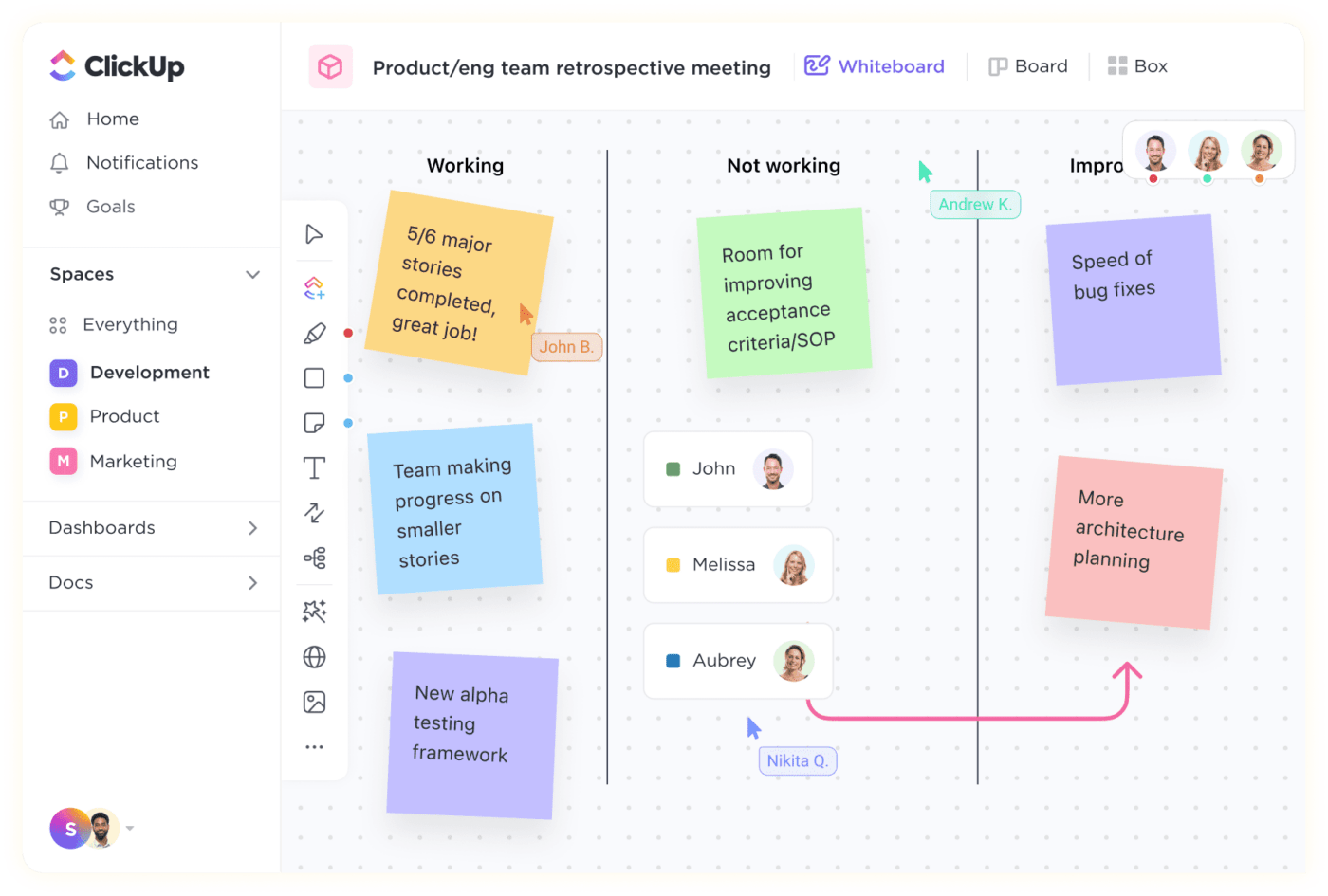
قم بتبسيط التواصل وشحن المشاريع بشكل أسرع مع برنامج إدارة المشاريع و ClickUp Whiteboards. قم بالعصف الذهني والتخطيط ووضع الاستراتيجيات والتواصل مع فريقك في الوقت الفعلي
كما أن التواصل الصريح مع دور كل فرد ووظائفه يعزز المساءلة. ولأن كل عضو من أعضاء الفريق يعرف المهام التي يتحمل مسؤوليتها، فإن مساهمته في المشروع والعمل تكون واضحة.
يعزز التواصل المفتوح والشفاف من تحفيز الموظفين ورضاهم والاحتفاظ بهم. ومع ذلك، فهي واحدة من تحديات الفريق الافتراضي . لكن المحصلة النهائية لمؤسستك على المحك ما لم يقود الفريق جميع الصفوف في اتجاه التواصل الفعال.
2. وضع أهداف واضحة للفريق
لا يمكن لفريقك أن يبقي عينيه على الجائزة إذا لم تفصح عن ماهية هذه الجائزة. لذا، ضع أهدافًا للفريق، سواء كنت جديدًا في إدارة الفريق أو حريصًا على أن تصبح أفضل في ذلك.
وسيركز فريقك على هدف معين ويصبح أقل عرضة للانحراف عنه. لأنه لنكن صادقين: إن الانحراف عن الأهداف في العمل دائمًا ما يكون طلبًا ملحًا واحدًا.

أنشئ أهدافًا ذكية في ClickUp بطرق متعددة لتتبع التقدم المحرز وتحقيق أهدافك
ولكن الأمر متروك لك - مدير الفريق - لتكون قدوة يحتذى بها. لا تستسلم لإغراء حل المشاكل أو بدء المهام التي قد تؤثر على أهداف فريقك.
بدلاً من ذلك، حدد أولويات تلك الأهداف وتأكد من أن فريقك يعمل على تحقيقها. استخدم أهداف ClickUp لإنشاء أهداف الفريق القابلة للتتبع ومراقبة التقدم المحرز تلقائيًا. على سبيل المثال، اربط المهام السريعة بخطة واحدة أو حدد أهداف المبيعات والإيرادات الشهرية. تتضمن إدارة الفريق قياس أداء الفريق باستمرار. لذا، تأكد من أن أهدافك في متناول اليد.
3. تقديم التغذية الراجعة بانتظام
التحسين المستمر هو ركيزة أي عمل تجاري ناجح. والتغذية الراجعة البناءة والقابلة للتنفيذ هي السبيل لتحقيق ذلك. أخبر فريقك بما يلي المجالات التي يجب عليهم تحسينها .
ولكن خذ أيضًا ملاحظاتهم وحاول أن تجعل مهمة فريقك أسهل وبيئة العمل أكثر صحة. امنح إمكانية الوصول إلى موارد جديدة، وساعد في اتخاذ القرار, التوسط في تواصل الفريق ، أو تقديم نصائح لتخطيط يوم أعضاء فريقك بشكل أكثر كفاءة.
كما يمكنك التواصل مع إدارة الفريق الأعلى أو وضع معايير الفريق في مكانها لدعم فريقك. عقد متكرر جلسات التغذية الراجعة . وتقدير مساهمة أعضاء فريقك في الفريق.
إنها استراتيجية ممتازة لتحسين أداء الفريق وبناء الثقة ورفع الروح المعنوية. كما أنها أيضًا نهج مضاد للرصاص لتعزيز صحة مشاريعك.
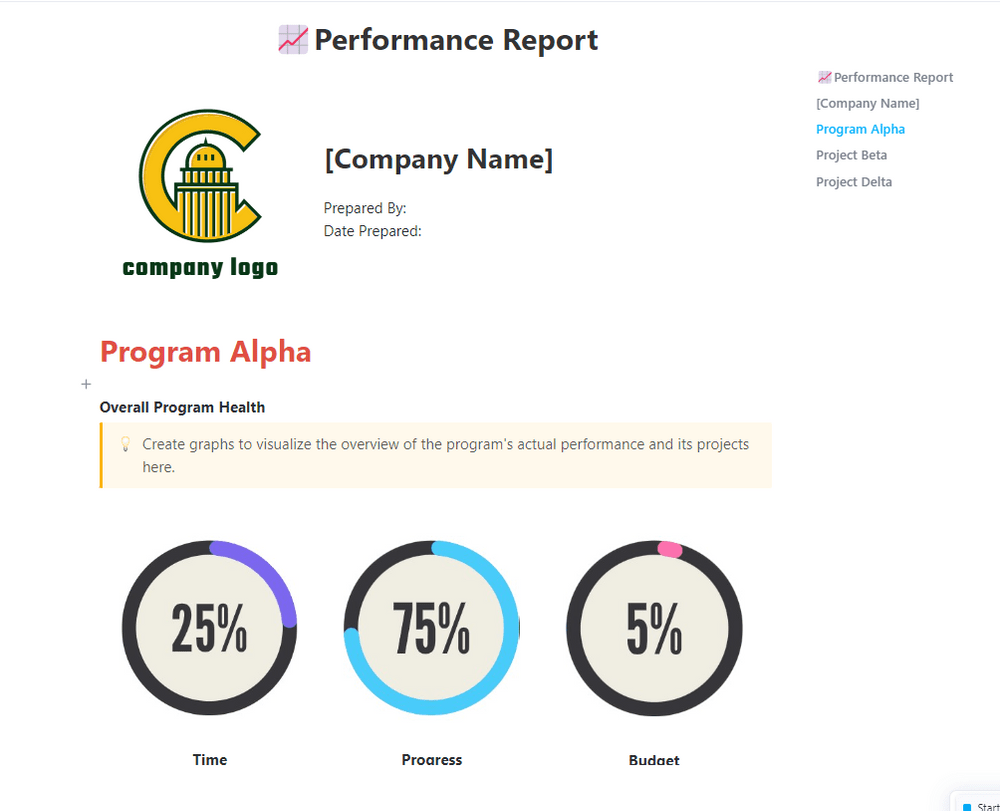
ضع كل شيء يتعلق بأهداف فريقك وأدائه في هذا القالب المفيد
جرب قالب تقرير الأداء الخاص ب ClickUp للإبلاغ بانتظام عن التقدم العام لجميع مشاريعك والتأكد من توثيق إدارة الفريق بشكل جيد.
4. تفويض المهام
أنت تعرف كفاءات أعضاء فريقك ومستوى خبرتهم، أليس كذلك؟ ولا يمكنك إيجاد الوقت للقيام بتلك المهمة التي تعرف أنهم قادرون على القيام بها؟ أو هل تحتاج إلى توسيع نطاق نتائج فريقك؟ حسنًا، إذًا حان وقت التفويض !
لقد قمت بتعيين فريقك لأنهم بارعون في عملهم. لهذا السبب يجب أن تثق في إحساسهم بالمسؤولية ومهاراتهم. تأكد من أنك لا تُحمّلهم فوق طاقتهم إلى الحد الذي يعجزون فيه عن التسليم في الوقت المحدد بجودة مقبولة.

تصوّر المهام والمشروعات وسير العمل بالطريقة التي تناسبك بشكل أفضل مع أكثر من 15 طريقة عرض قابلة للتخصيص من ClickUp مهارات إدارة الفريق ضرورية لتحقيق التوازن بين أعباء العمل و ClickUp هو حليفك في إدارة المهام. فهو يسمح لك بتخطيط عبء العمل لأعضاء فريقك ومعرفة متى تقفز للمساعدة أو تتبع التقدم المحرز. استخدم تعقب الوقت الخاص بـ ClickUp لاختبار تقديراتك وتنقيحها وإدارة أعباء العمل بشكل لا تشوبه شائبة.
بالإضافة إلى ذلك، تُعد طرق عرض الجدول الزمني وأعباء العمل في ClickUp رائعة لتخطيط جداول فريقك الزمنية واستخدامه وقدراته.
5. إدارة الوقت
قادة الفرق الفعّالون بارعون في إدارة الوقت. فهم يحددون أولويات المهام بحيث يعرف كل عضو في الفريق ما يجب القيام به أولاً. ويخططون أيضًا للوقت الذي سيقضونه في كل مهمة من أجل أفضل استراتيجية لإدارة الفريق.
ولكن الأمر هو يجب أن تكون تقديرات الوقت دقيقة قدر الإمكان. لأنه كلما كانت أكثر دقة، كلما كان فريقك أقل توتراً وأكثر إنتاجية. وهذه هي الطريقة التي سيطور بها فريقك حياتهم المهنية.
تمكن إدارة الوقت المديرين من تحديد أوجه القصور أيضًا. وبمجرد أن يصبحوا على دراية بالاختناقات أو انخفاض عدد الموظفين، يمكنهم التصرف حيال ذلك.

إنشاء جداول زمنية ومراقبة الوقت المتعقب في ClickUp
الآن، لكي يتمكن المديرون من إجراء تقديرات دقيقة للوقت، يحتاجون إلى بيانات تاريخية. ويحتاجون إلى أداة لإمكانيات تتبع وقت المشروع - مثل ClickUp - لتعيين المدد الزمنية وتتبع الوقت وعرض تقارير الوقت.
استخدم ClickUp لمقارنة الوقت الذي تتبعه فريقك مع تقديراتك الزمنية. يمنحك ذلك نظرة عامة على الوقت المتبقي في كل مهمة ويحدد ما إذا كان فريقك يسير وفق الجدول الزمني المحدد لتحقيق أهدافه.
6. تسوية مشاكل الفريق
بصدق معالجة أداء العمل أو المشاكل السلوكية مع أعضاء الفريق قد تكون شاقة. وعادة ما تكون المحادثات حول هذه المواضيع مرهقة للأعصاب.
ولكن لا نجاح أو نمو للفريق بدون بعض المحادثات الصعبة على طول الطريق. تتمحور إدارة الفريق حول تسوية هذه القضايا.
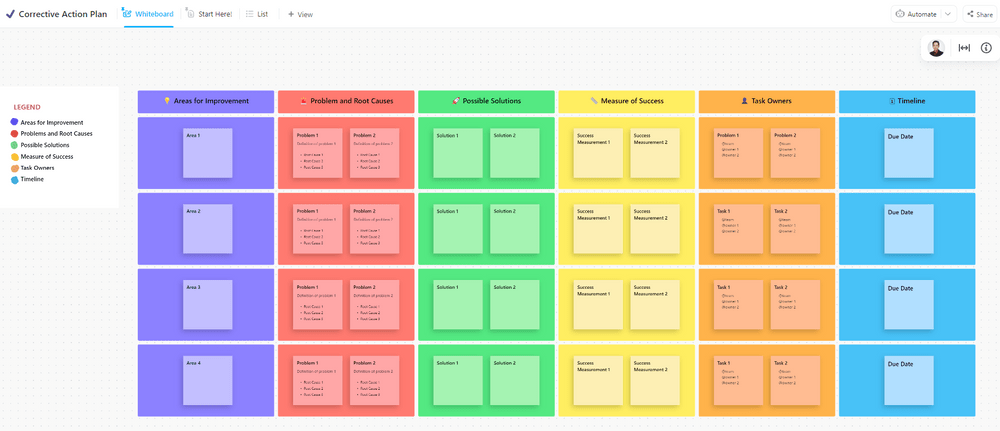
يساعد قالب خطة العمل التصحيحية ClickUp في تنظيم المناقشات الصعبة ونقاط الحوار مع فريقك قالب خطة العمل التصحيحية من ClickUp هو المورد المثالي للمديرين لإعداد تلك المناقشات وإجرائها. وهو يحدد مجالات التحسين والمشاكل والأسباب الجذرية والحلول الممكنة لإصلاح تلك المشاكل.
يحتوي نموذج إدارة الفريق هذا أيضًا على مقاييس النجاح، وأسماء أعضاء الفريق المسؤولين، وتواريخ الاستحقاق. اكتب كل شيء في القالب، حتى يعرف أعضاء فريقك الخطوات التصحيحية التي يجب اعتمادها. وفي وقت لاحق، استخدم المستند كمرجع للتحقق من التقدم المحرز.
7. التوظيف بفعالية وكفاءة
عاجلاً أم آجلاً، يجب على أي مدير فريق توظيف أعضاء الفريق الجدد. وأحد أجزاء هذه العملية هو تأهيل الموظفين الجدد.
وذلك عندما ترحب بهم في الفريق وتدمجهم في الثقافة التنظيمية. إنه أيضًا الوقت المناسب لتعريف أعضاء الفريق بالمواد و أدوات الاجتماع يحتاجون إلى أن يكونوا منتجين
التهيئة الفعالة هي استثمار لمدة عام تقريبًا. ولكنه يؤثر بشكل مباشر على الاحتفاظ بالموظفين. إنه أمر استراتيجي ومؤثر لهذه الدرجة بالنسبة لعملك.

كل ما تحتاجه لتنظيم عملية التوظيف، وتعيين الموارد، وجميع المرشحين لديك
استخدم قالب توظيف المرشحين في ClickUp للتأهيل السلس للموظفين الجدد. فهو يضمن أنهم يعرفون بالضبط ما تحتاج منهم القيام به خلال تلك الفترة.
8. خلق ثقافة إيجابية للفريق
في بيئة عمل صحية يجري المديرون وأعضاء الفريق حوارات إيجابية. يناقشون أسلوب الإدارة, القيم الأساسية للشركة والثقافة التنظيمية، وأي شيء قد يؤثر على أداء بعضنا البعض وأهداف الفريق.
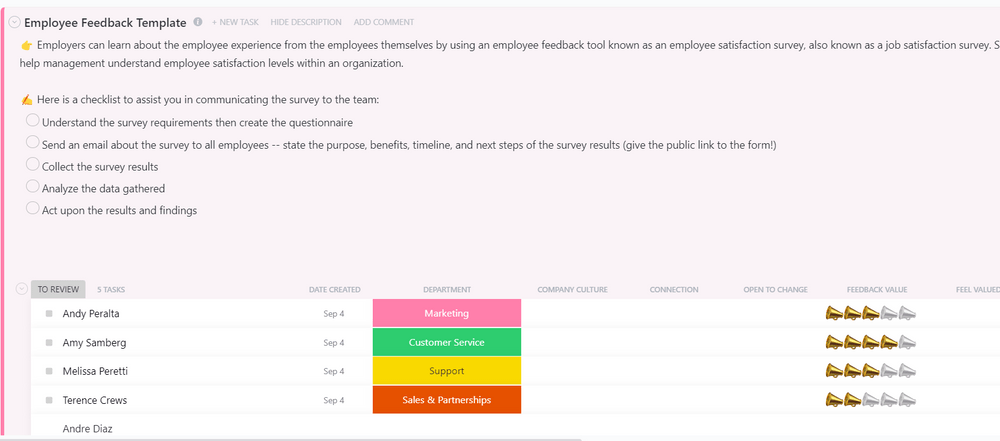
احصل على ملاحظات حقيقية وقابلة للتنفيذ من موظفيك في قالب واحد قابل للتتبع والتنظيم
بصفتك مدير فريق، فإن الاعتماد على الموظف نموذج الملاحظات لجمع الآراء مفيد للغاية. وهو شكل رائع لمعالجة المواضيع المعقدة مثل الرواتب والمزايا. استخدم قالب ملاحظات الموظفين في ClickUp لإجراء استبيانات رضا الموظفين.
9. احتفل بانتصارات الفريق
يجب على المديرين تقدير جهود ونتائج أعضاء فريقهم. وبالتالي، يصبح الفريق أكثر تماسكًا ومرونة.
لكن الفوائد فردية أيضًا. يشعر أعضاء الفريق بالتقدير، ويتعزز شعورهم بالهدف في العمل، مما يغذي رغبتهم في الوصول إلى أهداف أعلى. وهكذا، يتقدمون في حياتهم المهنية، ويفوز الجميع.
كلها أسباب وجيهة لعدم الانتظار لوقت تكون فيه أقل انشغالاً! خصص وقتًا للاحتفال بإنجازات فريقك. بالإضافة إلى ذلك، خصص خانة في جدول أعمالك للإشادة بنتائجهم مرة واحدة على الأقل في السنة. وفيما بين ذلك، قدم التعزيز الإيجابي والتغذية الراجعة المناسبة.
10. تعزيز تعاون الفريق
لا شيء يضاهي تعاون الفريق عندما يتعلق الأمر بزيادة مشاركة الموظفين. تنجز الفرق التعاونية المزيد من المهام بشكل أسرع وبأقل قدر من الدراما.
 مراقبة المشروع
التحديثات، وإدارة مهام سير العمل، والتعاون مع الفريق، كل ذلك من مساحة عمل ClickUp الخاصة بك
مراقبة المشروع
التحديثات، وإدارة مهام سير العمل، والتعاون مع الفريق، كل ذلك من مساحة عمل ClickUp الخاصة بك
كما أن أعضاء الفريق الذين يطرحون الأفكار معاً ويساعدون بعضهم البعض يكونون أكثر سعادة في العمل. وهذه السعادة تُشعل إنتاجيتهم وتجعلهم يشعرون بالأمان عند مشاركة المشاكل.
والآن، خمن ماذا تفعل هذه البيئة لفريقك؟ هذا صحيح! يجد أعضاء فريقك حلولاً إبداعية للتغلب على التحديات بشكل أسرع وأكثر كفاءة.
المسارات الوظيفية في إدارة الفريق
مهارات إدارة الفريق ذات قيمة عبر العديد من المسارات الوظيفية. سواءً كنت مديراً طموحاً أو تتطلع إلى تعزيز مسارك القيادي، إليك بعضاً من الأدوار الإدارية حيث تحظى تلك المهارات بتقدير كبير:
مدير مشروع
يقوم مدير المشروع بتنسيق تخطيط وتنفيذ وإنجاز مشاريع محددة داخل المؤسسة، مما يضمن توافق هذه المبادرات مع أهداف الشركة وغاياتها. وهم بارعون في تخصيص الموارد، وإدارة الميزانيات، وقيادة الفرق متعددة الوظائف لتحقيق النجاح بينما الحفاظ على المواعيد النهائية الضيقة .
راجع دليلنا على a يوم في حياة مدير المشروع !
مدير العمليات
يتسم مديرو العمليات بأهمية بالغة للحفاظ على كفاءة الأنشطة اليومية للشركة. فهم يسعون جاهدين لتعزيز جودة العمليات الداخلية, ضمان رضا العملاء, والعمل على تحسين إنتاجية الشركة. وغالباً ما يتضمن دورهم التخطيط الاستراتيجي والإشراف على مهام الموارد البشرية رفيعة المستوى.
مدير الموارد البشرية
يحتل مديرو الموارد البشرية موقع الصدارة في خلق ثقافة مزدهرة في مكان العمل. فهم يشرفون على التوظيف وإدارة علاقات الموظفين وتصميم الخطط الاستراتيجية للاحتفاظ بالموظفين وتطويرهم. دورهم محوري في رعاية موظفي الشركة، ومواءمة أداء الموظفين مع متطلبات العمل الأهداف التنظيمية .
قائد الفريق
يقدم قادة الفرق الإرشاد والتوجيه والتوجيه والقيادة لمجموعة محددة بغرض تحقيق نتيجة رئيسية أو مجموعة من النتائج المتوائمة. وهم يلعبون دورًا محوريًا في ديناميكيات الفريق وتحفيز أعضاء الفريق، و تقييم الأداء بينما يبقى عضوًا عاملًا في الفريق.
مدير المنتج
يكون مديرو المنتجات مسؤولين عن الاستراتيجية وخارطة الطريق وتعريف ميزات المنتج أو خط الإنتاج. وغالباً ما يقودون فرق متعددة الوظائف بدءًا من تصور المنتج وصولاً إلى إطلاقه. تُعد مهارات التواصل والتحليل الممتازة ضرورية أثناء التنسيق بين مختلف أصحاب المصلحة لضمان تلبية المنتج لاحتياجات السوق.
راجع دليلنا على a_ يوم في حياة مدير المنتج !
إعطاء الأولوية لمهارات إدارة فريقك
الإدارة الفعالة للفريق أمر بالغ الأهمية لـ تحفيز أعضاء الفريق ويقطع شوطًا طويلاً بالنسبة للشركات. فهو يضع الأساس لفرق عالية الأداء تتواصل بشكل جيد وتتعاون وتبتكر.
كما أنه يولد جوًا من الثقة والاحترام، مما يبقي الفريق على المسار الصحيح والمضي قدمًا. إذا كنت تستخدم الأدوات المناسبة، فسوف تحافظ على التركيز القوي على المهام التي بين يديك، وتقلل من معدل دوران الموظفين، وتحسن ولاء العملاء.
وهذا يساعد الجميع على أن يكونوا أكثر رغبة في التعلم بينما تزيد من رضا الموظفين. لذا، اعثر على الأداة التي يمكن أن تناسبك بشكل أفضل.
